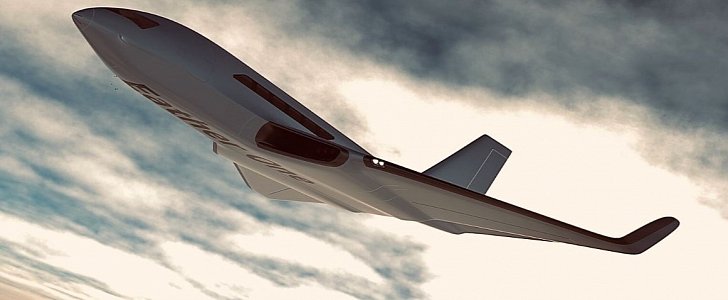Fully electric passenger planes are still in the realm of sci-fiction, but there’s no harm done in dreaming about a future when they become norm. Eather One is one such dream.
Today’s passenger planes, even hybrids, come with a massive carbon footprint, this being one of the biggest complaints against the aviation industry. With pledges from all the major companies that they will strive to reduce emissions in the next year, it’s become clear that incorporating clear technology is a must.
The auto industry is already in the midst of the so-called electric revolution, but aviation is far behind. Industrial designer Michal Bonikowski has created a concept for a fully-electric airplane that would use air friction to generate power while in the air.
He calls it Eather One. The concept is inspired by the Airbus MAVERIC concept (Model Aircraft for Validation and Experimentation of Robust Innovative Controls), which was unveiled in February this year and uses a new wing design and engine placement to reduce fuel consumption by at least 20 percent.
“I enjoy all attempts to revolutionize flying,” Bonikowski says. “I have been thinking a lot about this lately, and what could happen if Airbus would like to create an electric plane.”
Eather One is all-electric and, more importantly, wouldn’t require large battery banks to stay in the air, thus maximizing available space and decreasing weight. This is done by recovering air friction and converting it into electric energy, which would power the motors.
Fuel tanks would be replaced with triboelectric nanogenerators on the wings, Bonikowski says. “Using the vibrations of the structure and friction generated by the bending of wings during the flight, [they] can generate the energy needed to power several smaller electric motors,” he explains on his website.
This would make the plane completely self-sufficient during flight. The aircraft would still need battery banks for takeoff and landing, that is to say, during those times when friction wouldn’t be enough to provide juice. But they would be considerably smaller than those needed to keep it in the air throughout its entire flight.
The auto industry is already in the midst of the so-called electric revolution, but aviation is far behind. Industrial designer Michal Bonikowski has created a concept for a fully-electric airplane that would use air friction to generate power while in the air.
He calls it Eather One. The concept is inspired by the Airbus MAVERIC concept (Model Aircraft for Validation and Experimentation of Robust Innovative Controls), which was unveiled in February this year and uses a new wing design and engine placement to reduce fuel consumption by at least 20 percent.
“I enjoy all attempts to revolutionize flying,” Bonikowski says. “I have been thinking a lot about this lately, and what could happen if Airbus would like to create an electric plane.”
Eather One is all-electric and, more importantly, wouldn’t require large battery banks to stay in the air, thus maximizing available space and decreasing weight. This is done by recovering air friction and converting it into electric energy, which would power the motors.
Fuel tanks would be replaced with triboelectric nanogenerators on the wings, Bonikowski says. “Using the vibrations of the structure and friction generated by the bending of wings during the flight, [they] can generate the energy needed to power several smaller electric motors,” he explains on his website.
This would make the plane completely self-sufficient during flight. The aircraft would still need battery banks for takeoff and landing, that is to say, during those times when friction wouldn’t be enough to provide juice. But they would be considerably smaller than those needed to keep it in the air throughout its entire flight.




